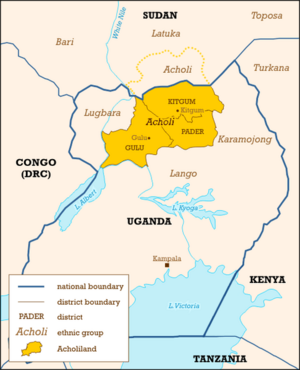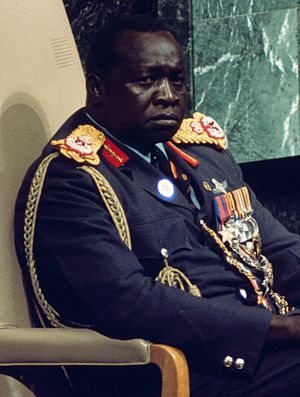History of Uganda facts for kids
The history of Uganda tells the story of the people who lived in the area now known as Uganda, both before it became a country and after. Scientists have found tools from the Stone Age, showing that people have lived here for at least 50,000 years. Over time, people who likely spoke Central Sudanic languages began to clear the forests for farming.
In 1894, Uganda became a "protectorate" of the British Empire. This meant Britain controlled Uganda's affairs. In 1962, the United Kingdom gave Uganda its independence. Sir Edward Muteesa Walugembe became the first President of Uganda and also the traditional king (Kabaka) of Buganda. Later, in 1971, Idi Amin took power from Milton Obote in a military takeover. Amin ruled for eight years until he was removed in 1979 during the Uganda-Tanzania War. After several other leaders, Yoweri Museveni became president in 1986 and has led Uganda ever since.
Contents
Ancient Times
Evidence shows that humans were active in Uganda at least 50,000 years ago. Some findings even suggest it could be as far back as 100,000 years. This is known from Paleolithic (Stone Age) tools found near Lake Victoria and along the Kagera River.
People who spoke Bantu languages slowly moved into the area. They gradually cleared the forests for farming. These groups also raised goats and chickens. By 400 BCE, they likely kept some cattle too. Their farming skills and knowledge of iron-forging helped them clear land and feed more people. They replaced smaller groups of hunter-gatherers, who moved to the mountains.
Around the first century CE, and possibly earlier in nearby Tanzania, some Bantu-speaking people became skilled at working with iron. They learned to melt iron to make strong carbon steel. Even though much of this happened outside Uganda's current borders, iron was soon mined and melted in many parts of Uganda.
British Control (1894–1961)
In the 1890s, about 32,000 workers from British India were brought to East Africa. They came to build the Uganda Railway. Most of these workers went home after the railway was finished. However, about 6,724 decided to stay in East Africa. Many of them became traders and helped develop businesses like cotton processing and clothing sales.
Between 1900 and 1920, a serious illness called sleeping sickness spread in southern Uganda. This happened along the northern shores of Lake Victoria. Sadly, more than 250,000 people died during this time.
Early Independence (1962–71)
Britain gave Uganda its independence in 1962. Before that, elections for self-governance were held on March 1, 1961. Benedicto Kiwanuka became the first chief minister.
Milton Obote was elected Prime Minister in April 1962. Uganda became a republic in October 1962. It also remained a member of the Commonwealth of Nations, a group of countries that were once part of the British Empire.
In the years that followed, there were disagreements about how Uganda should be governed. Some people wanted a strong central government. Others wanted a looser system where local kingdoms had more power. In February 1966, Prime Minister Milton Obote took control. He suspended the constitution and removed the positions of president and vice president. In September 1967, a new constitution was put in place. It made Uganda a republic, gave the president more power, and ended the traditional kingdoms.
Uganda Under Idi Amin (1971–79)
On January 25, 1971, there was a military takeover. Obote was removed from power, and Idi Amin became the country's ruler. Amin ruled Uganda with the military for eight years. During his time in power, many people were harmed or killed as he tried to keep control.
In 1972, Amin introduced a policy called "Africanization." Because of this, about 40,000 people of Indian origin who had British passports were forced to leave Uganda. About 7,000 were invited to move to Canada, but only some accepted. The loss of these business-minded people greatly harmed Uganda's economy.
Amin's eight-year rule led to a decline in the economy. It also caused social problems and many human rights violations. The Acholi and Langi groups in northern Uganda were especially targeted. This was because they had supported Obote and were a large part of the army.
Amin's rule ended after the Uganda-Tanzania War. This conflict began with a small border fight. Ugandan exiles had a camp near the border, and the Ugandan Army attacked Tanzania. In October 1978, the Tanzanian Armed Forces pushed back this attack. With help from Ugandan exiles, they invaded Uganda. Amin's troops were helped by soldiers from Libya. On April 11, 1979, Uganda's capital, Kampala, was captured. Amin then fled to Libya.
Uganda Since 1979
After Amin was removed, a group called the Uganda National Liberation Front formed a temporary government. Yusuf Lule became president, and Jeremiah Lucas Opira was the Secretary-General. This government set up a system with ministers and a parliament-like group called the National Consultative Commission (NCC).
However, there were still disagreements about power. In June 1979, the NCC replaced Lule with Godfrey Binaisa. Then, in May 1980, Binaisa was also removed. After that, Uganda was ruled by a military group led by Paulo Muwanga.
In December 1980, elections brought Milton Obote's party back to power, with Muwanga as vice president. Under Obote, the security forces were known for serious human rights problems. They tried to stop a rebellion led by Yoweri Museveni. In their efforts, they caused much damage to parts of the country, especially around Luwero, north of Kampala.

This rebellion was called the "Ugandan Bush War." It was fought by the National Resistance Army (NRA), led by Yoweri Museveni, and other rebel groups. During this conflict, the army carried out mass killings of people who were not fighters.
Obote was overthrown on July 27, 1985. An army group, mostly made up of Acholi soldiers, took Kampala. They announced a military government. Obote fled to Zambia. The new government, led by Gen. Tito Okello, promised to respect human rights, end tribal conflicts, and hold fair elections. However, serious human rights problems continued as the Okello government tried to stop the NRA.
Negotiations between the Okello government and the NRA took place in Nairobi in late 1985. The president of Kenya, Daniel arap Moi, tried to help them agree on a ceasefire and a shared government. Even though they agreed to a ceasefire, the NRA continued fighting. They captured Kampala and the country in late January 1986. This forced Okello's forces to flee north. Museveni's forces then formed a new government, with Museveni as president.
After taking power, the government led by Museveni's group, the National Resistance Movement (NRM), largely stopped the human rights abuses of earlier governments. They also began to allow more political freedom and freedom of the press. They made big changes to the economy after talking with international organizations.
However, from 1986 to 1994, different rebel groups fought against Museveni's government. Most of the fighting happened in the north and east of the country. Important rebel groups included the Uganda People's Democratic Army (UPDA) and Joseph Kony's army, which later became the Lord's Resistance Army.
In 1996, Uganda strongly supported the removal of Zairean President Mobutu Sese Seko during the First Congo War. They supported rebel leader Laurent-Désiré Kabila.
21st Century
Between 1998 and 2003, the Ugandan Army was involved in the Second Congo War in the Democratic Republic of the Congo. Uganda continued to support some rebel groups there.
In August 2005, the Parliament voted to change the constitution. This change removed limits on how many terms a president could serve. This allowed Museveni to run for a third term if he wanted. In a vote in July 2005, 92.5 percent of voters supported bringing back multiparty politics. This ended the "movement" system, where there were no political parties. Kizza Besigye, a political rival of Museveni, returned from exile in October 2005 and ran for president in the 2006 elections. Museveni won the presidential election in February 2006.
The 2016 Ugandan general election was held on February 18, 2016, to elect the president and parliament. Before the election, Museveni said that forming an East African Federation was a main goal. This federation would unite Uganda, Tanzania, Kenya, Rwanda, Burundi, and South Sudan. In September 2018, a committee was formed to start writing a regional constitution. A draft constitution for a confederation was planned to be ready by 2021, with the confederacy starting by 2023.
The 2021 Ugandan general election re-elected President Museveni for a sixth term. However, international observers noted concerns about government actions. These included issues with independent media and opposition campaigning, the arrest of opposition leaders, and the shutdown of the internet. Official results stated that Museveni won with 58% of the vote, while popstar-turned-politician Bobi Wine received 35%. The opposition challenged these results due to concerns about fairness.
See also
 In Spanish: Historia de Uganda para niños
In Spanish: Historia de Uganda para niños
- Empire of Kitara
- Early History of Uganda
- History of East Africa
- History of Africa
- History of Buganda
- Luo (family of ethnic groups)
- Military History of Uganda
- Politics of Uganda
- Rock art of Uganda
- Kampala history and timeline


